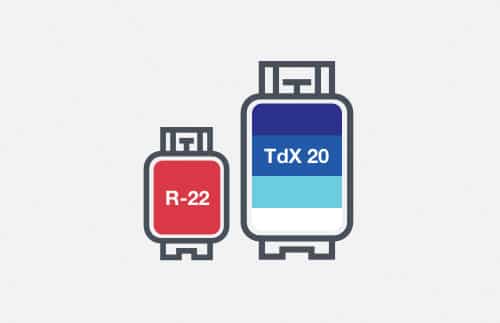New refrigerant maker Bluon rescues the HVAC industry from environmental catastrophe

[Photo: iStock]
 Download a PDF of this story.
Download a PDF of this story.
To learn more, visit Bluon.
In 1987, 197 countries signed the Montréal Protocol as part of a global effort to prevent irreparable damage to the Earth’s ozone layer. The intent was to discontinue the use of ozone-depleting substances, which are commonly used in refrigerants within HVAC equipment, over a period of decades, allowing time for the industry to adapt. CFCs (chlorofluorocarbons), the worst offenders, were the first to be phased out. More recently, HCFCs (hydrochlorofluorocarbons) are being phased out. The process began in 2004 and ends in 2020, at which point no HCFCs will be manufactured or imported into the U.S. or the developed world. In the context of commercial and residential HVAC systems, this primarily refers to the refrigerant known as R-22.
This noble effort has already begun to heal the ozone layer. But along the way, a new, unexpected problem has emerged. According to Peter Capuciati, a physicist who has devoted the last seven years to finding solutions to overcome limitations in HVAC efficiency, the replacement refrigerants now on the market—while they don’t contribute to ozone depletion—actually reduce the performance of HVAC systems, increasing energy consumption by anywhere from 5 to 30%, depending on the product.
“The whole idea of the R-22 phase-out is to have an environmental benefit, so it’s actually backfiring in the sense that all of the prior replacements are having a negative impact on the planet due to their increased electricity consumption,” Capuciati says. In 2011, Capuciati cofounded Bluon, a new refrigerant manufacturer and HVAC service provider, to address this shortcoming in the market.

[Photo: iStock]
Racing the Clock
Worldwide, HVAC-R systems consume approximately 40% of all electricity. Given that electricity accounts for 30% of greenhouse gas emissions in the U.S., the HVAC-R share of the global warming crisis stands around 12%—equivalent to half of all the cars and trucks on the road, which certainly get far more attention as a climate change culprit. Unfortunately, as the 2020 deadline for phasing out R-22 approaches, that number stands to rise as building owners and managers scramble to replace their refrigerant with one of the handful of non-ozone-depleting products approved thus far.
After several years of experimentation, Bluon came up with a refrigerant formula unlike any other on the market. It reduces energy use by 5 to 25%, depending on the application, with an average energy savings of 15 to 18%. Known as TdX 20, the product achieves these results by carrying more heat at lower pressure, maximizing the use of the entire coil and minimizing system losses inherent to HVAC equipment.
“We tried several hundred formulas, testing each one on various pieces of equipment in the field and in the lab, to find an approach that would actually increase efficiency,” says Capuciati, who is now the executive chairman of Bluon’s board of directors. “That was our sole mission in life for about three years. Finally, we discovered something unexpected that wasn’t showing up in the models. That if we stacked five or more different refrigerants together, enabling them to phase-change in sequence (vaporize), a domino effect occurred resulting in more productivity from the coil and less work from the compressor—thus lowering electrical consumption.”
“The support from bluon has been phenomenal.”
Rich Hopkins, director of engineering at PMRG
By September 2016, TdX 20 had cleared the regulatory hurdles at the EPA and other permitting agencies and received its official ASHRAE designation—R-458A—the final step to enter the marketplace. It was not a moment too soon, says Douglas Reinke, Bluon’s president and CEO, not just because of the looming 2020 deadline and the urgency of fighting climate change, but because R-22 had suddenly spiked in price. Now that the end of R-22 production is drawing near and new supply is drying up, re-claimers and suppliers who have been stocking up are taking advantage of the situation, creating a supply and demand dynamic that is deeply unfavorable to building owners and end-users.
Goodbye Skyrocketing Costs and Inefficiency
As TdX 20 production ramped up late last year, they were able to drop their price to $13 per pound wholesale at a supply house, while the price of R-22 continues to rise above and beyond $25 per pound. By 2020, R-22 is projected to cost $40 per pound or more.
“Sixty-five percent of HVAC systems still run on R-22, and in total they require about 200 million pounds of replacement refrigerant per year for repairs and maintenance purposes,” Reinke says. “With the price skyrocketing, everyone is looking for alternatives, but unfortunately all the alternatives, except for Bluon TdX 20, are less efficient, so they will actually increase electricity bills. And because HVAC systems using TdX 20 run at lower pressures and compressor temperatures, they last longer and need fewer repairs. All those factors combined make a pretty powerful business case for the end-user.”
When the Montréal Protocol was drafted, the vision was that building owners the world over would invest in new HVAC equipment designed to run on a different type of refrigerant, adds Capuciati. “That didn’t turn out to be economically viable for most, which is why there are still so many of the legacy R-22 units out there, even as we approach 2020.”
According to Bluon’s cost analyses, replacing the HVAC equipment on a 100,000-square-foot commercial building with a modern system costs about $1 million, the equivalent of $3,000 per ton of capacity. In comparison, replacing existing refrigerant with TdX 20 costs about $150 per ton, or $45,000 for a 100,000-square-foot building. The resulting energy savings pay for the investment in one to three years, depending on the building, system, and cost of electricity.

[Photo: iStock]
Big Change, Big Names
Bluon’s list of clients has grown dramatically during the company’s short existence. Their approach has led to deals with major real estate companies like CBRE and PMRG, energy management providers such as Schneider Electric, health care institutions like Kaiser Permanente and corporations ranging from Carl’s Jr. to ESPN. As a testament to Bluon’s innovative global warming solution, movie star and environmental activist Leonardo DiCaprio came on board as an advisor and investor in the spring of 2017.
Rich Hopkins, the director of engineering for the western division of PMRG, a commercial real estate firm with more than 180 million square feet in its nationwide portfolio, can attest to the efficacy of TdX 20. It’s not just a concept on paper, he says; it works as advertised in real-world conditions. As a participant in Bluon’s product testing pilot, he’s been using TdX 20 for the last two years in the Anaheim Pacific Center, a class A high-rise in Southern California that is one of PMRG’s signature properties.
“I did a side-by-side comparison of a unit with R-22 and one with TdX 20 and tracked the results for about a year,” Hopkins says. “We put all kinds of gauges and sensors on the unit and were pleasantly surprised to find that the pressure and temperature dropped considerably, which is the best way to extend the lifespan of an HVAC system. We also saw about a 15% drop in energy use, which is helping us reduce our carbon footprint.”
Hopkins is now looking to roll out TdX 20 across the 18 million square feet of real estate he personally oversees throughout the West, from California to Arizona and Hawaii. As an engineer, there’s a big upshot to working with a company founded by technically minded problem solvers, he says. “They answer my calls, they come out and advise me. Doug will get on a plane and fly out to my site if I have any questions. The support from Bluon has been phenomenal.” Thanks to Bluon’s effort, it seems that the Montréal Protocol might fulfill its potential after all.
[Illustration: Courtesy of Bluon]
Get the Job Done Right with the Bluon Accreditation Program
A Resource for Mechanical Contractors
Jason Saunders, the service operations manager at the California-based HVAC contractor Indoor Environmental Services, was an early adopter of TdX 20 and has seen such demand for the product from his clients that he now has a number of Bluon-accredited technicians on his team. The Tier 1 accreditation, geared for systems 20 tons and under, can be completed online in less than an hour, while the Tier 2 option, for larger systems, also includes in-person training with a Bluon technician.
“It’s definitely something I value from a contractor standpoint because you would not want just anyone installing the product,” Saunders says. “It needs to be done in the right way and applied to the correct type of equipment.”
He says his team now offers to replace R-22 with TdX 20 any time they open a client’s system for maintenance or repairs, and they tout it at their monthly lunch-and-learns with customers. His clients have come to see it as a “no-brainer,” he says, especially now that the price of R-22 refrigerant has gone through the roof.
“We did our own independent R & D to make sure Bluon’s claims were realistic,” he says. “We’ve installed it in a number of units already, with excellent results. We really do believe it is
Learn more about the Bluon Sustainability breakthrough.

